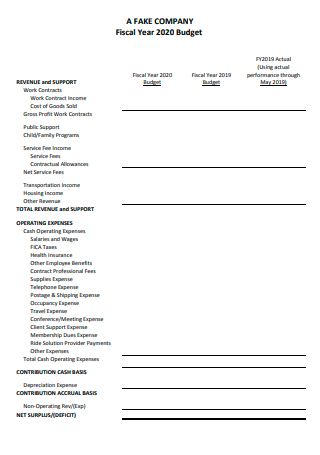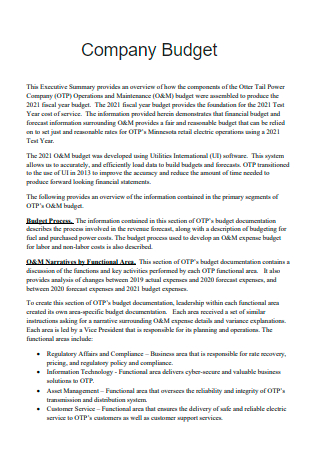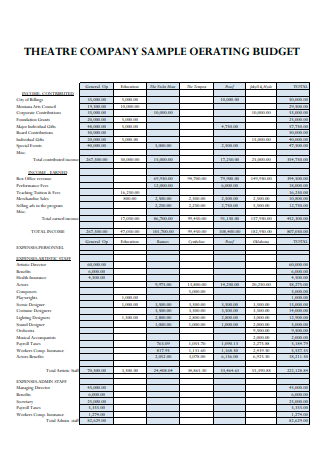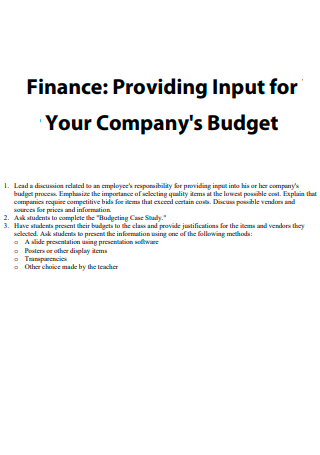7+ SAMPLE Company Budget
-

Company Budget Template
download now -

Gas Company Budget Plan
download now -

Company Budget Example
download now -

Public Company Accounting Budget
download now -

Theatre Company Operating Budget
download now -

Finance Company Budget
download now -

Basic Company Budget
download now -

Company Budget in PDF
download now
What Is a Company Budget?
A company budget is a forecast of your business’s spending based on your revenue and expenses. It identifies available capital, estimates expenditures, and assists you in forecasting revenue. A budget can help you plan your business activities and serve as a benchmark for establishing financial goals. It can assist you in overcoming both immediate and long-term obstacles. According to statistics, 61% of small businesses do not have a formal budget.
Benefits of a Budget
A proper budget should equip the business owner with the tools necessary to monitor the company’s financial performance and plan for both short- and long-term expenses ranging from new hires to the cost of expanding operations. Additionally, a budget enables a business owner to share their processes and budget with a governing body, such as a board of directors, and provide critical status updates to current and prospective investors. What you can do on a budget is as follows:
Types of Company Budgets
Your final budget usually comes from many other budgets made at a departmental level. Let’s look at the different types of budgets and how they help us write a business plan.
1. Master budget
A master budget is a compilation of budgets prepared at the lower level by various functional departments. Financial statements, cash forecasts, and financial plans are all inputs. Management teams use master budgets to plan the actions necessary to achieve their corporate objectives. In larger organizations, senior management is responsible for developing numerous versions of the master budget before it is finalized. Cash can then be allocated to specific business operations following the final evaluation. Although smaller organizations frequently create master budgets using spreadsheets, switching to efficient budgeting software eliminates errors.
2. Operating budget
An operating budget shows how much money a business will make and how much money it will spend for a certain amount of time. It looks a lot like a profit and loss report. It includes fixed, variable, capital, and other costs that aren’t for running the business. Even though this budget is a high-level summary report, each line item is backed up with important information. This information can help you see if the business is spending in line with its plans. People in most businesses start each year with a budget that they write up for the following year.
3. Cash budget
It allows you to figure out how money comes in and out of business over a certain amount of time. Organizations make cash budgets by looking at sales forecasts and production and figuring out how much money they have to pay and how much money they have to pay back. The information in this budget can help you figure out if you have enough money to run your business, if your money is being spent wisely, and if you’re on track to make money.
4. Financial budget
A business makes this budget to figure out how much money they’ll need to meet short-term and long-term needs. It considers assets, liabilities, and stakeholders’ equity essential parts of a balance sheet. These parts give you an overall picture of how well your business is doing.
5. Labor budget
Having a labor budget is essential for any business that plans to hire people to help it reach its goals. It helps you figure out how many people you’ll need to reach your goals and how much money you’ll need to pay them. It also helps you gather how much money to spend on seasonal workers.
6. Static budget
As the name implies, this budget is a projection of revenue and expenses that will remain constant for the year. The line items in this funding can be utilized as targets to achieve regardless of whether sales increase or fall. Static budgets are typically generated by charitable organizations, educational institutions, or government agencies allotted a predetermined sum for each activity area.
7. Production budget
Your production budget specifies the quantity of each product manufactured to meet sales and inventory requirements. To create a production budget, you’ll need to know the anticipated number of units sold, the required level of finishing inventory, and the number of units in your beginning inventory. Your production budget contributes to determining the cost of production, which contributes to determining the product’s pricing. Maintain strict control over your production budget. Adjust your manufacturing budget accordingly if sales and demand increase or drop.
How To Create a Company Budget
According to research, a few of the most common causes for small businesses to fail include price and cost concerns, losing focus, and running out of cash. These concerns can be avoided by establishing a reasonable budget. Before focusing on the budget, you must first choose which areas of your organization you wish to improve. This enables you to determine what you can do with your finances. You can then create short- and long-term goals based on that list. Your cash inflows and outflows will directly impact these objectives. A short-term objective can be to pay off debt or acquire new equipment. Long-term goals, such as setting aside marketing spending, are critical because they are linked to your business’s overall success. You should be pragmatic in your goal setting. They should be entirely dependent on the capacity of your organization to spend and save. Once you’ve established your objectives, you may develop an adequate, watertight budget following these procedures.
1. Cost analysis
Before you begin writing a budget, you should research the operating costs of your firm. Knowing your expenditures inside and out provides the foundation for developing an efficient spending plan. If you develop a preliminary budget and later learn that you require additional funds for commercial activities, your goals will be jeopardized. Your budget should be set up so that when your firm grows, you can raise sales and profit enough to cover your expanding expenses. Your budget should account for fixed, variable, one-time, and unforeseen costs. Rent, mortgages, salaries, internet, accounting services, and insurance are all examples of fixed expenses. Variable costs include the cost of products sold and labor commissions. There is little danger in overestimating the costs involved, as you will require sufficient cash to cover future expenses. If your firm is new, you must also factor in start-up expenditures. Budgeting in this manner enables you to make educated decisions and address any unexpected financial surprises.
2. Cost negotiations with suppliers
This stage benefits firms operating for more than a year and relying on suppliers to market their products. Before creating your annual budget, speak with your suppliers and see if you can negotiate cheaper rates on the materials, products, or services you require before making your payments. Negotiations enable you to establish trustworthiness with your suppliers. This will be advantageous when inflows of cash are limited. For instance, you may run a seasonal business. When you have sufficient cash on hand, you can pay advance amounts to your suppliers to compensate for periods you cannot make payments. The primary objective here is to identify efficient methods for lowering the cost of conducting business.
3. Calculate your revenue.
Many firms have collapsed in the past due to overestimating income and borrowing more funds to satisfy operating requirements. This defeats the purpose of making a budget in the first place. It’s good to look back at previous revenue records to keep things reasonable. Businesses must track revenue on a monthly, quarterly, and annual basis. The income figures from the prior year might be used as a benchmark for the coming year. It’s critical to rely only on empirical evidence. This will assist you in setting realistic goals for your team, which will eventually lead to the expansion of your company.
4. Determine your gross profit margins.
The gross profit margin is the currency remaining after all expenses are paid at the end of the year. It provides insight into your business’s financial health. Here’s an illustration of why you should be familiar with this parameter while building a budget. Assume your business earned $5,000,000 in revenue but still owes money. Your expenses exceed your revenue towards the end of the year, which is not a good indicator for a developing business. This indicates that you must discover and remove expenses that are not beneficial to the firm. The best approach to achieve this is to itemize all materials’ cost of products sold and deduct them from total sales income. This information is required to obtain a complete view of your business’s performance, enabling you to boost profit and decrease costs.
5. Project cash flow
Cash flow comprises two parts: customer payments and vendor payments. To keep your company’s cash flowing, you must balance these two factors. It’s critical to have flexible payment terms and the flexibility to take payments through conventional payment channels if you want to assure timely consumer payments. Regrettably, you will have to deal with consumers who do not adhere to the agreements. Missed payments could have an impact on your cash flow estimate. You may urge clients to pay by giving them a grace period and enforcing harsh late payment regulations. In addition, you should set aside money in your budget for ‘bad debt’ in case the consumer does not pay. You can set an amount for staff pay and travel expenses after knowing your incoming cash flow. You can also leave some funds to cover your fixed vendor costs. If you still have money left, you can contribute to business efforts like professional development or new equipment.
6. Take seasonal and industry trends into account.
It is implausible to assume that you will accomplish every company objective and meet your monthly projections monthly. There will be months when the company is flourishing in a yearly cycle and months when sales are slow. Due to seasonal unpredictability and industry patterns, you’ll need to manage cash flow carefully to avoid the firm closing during slower seasons. While developing a budget, collect data on when your firm works best to overcome this obstacle. The objective should be to earn sufficient money during the peak months to support the firm throughout the off-seasons.
7. Establish spending objectives
Budgeting entails simply totaling your expenses and deducting them from your income. How prudently you spend your money determines the success of your firm. Goals establish a framework for determining if your money is being spent wisely and avoiding unnecessary expenses. For instance, if you are spending money on stationery utilized ineffectively for operational or marketing purposes, it may be time to reduce those expenditures. This money could be better spent on marketing activities that generate additional leads and income. Assess and invest in those expenses that will ultimately benefit your firm.
FAQs
What does a business budget for?
Regular revenue, expenses, capital expenditures, and obligations such as loans are all included. Your budget helps direct your business’s decision-making. Budgets are typically prepared for a fiscal year and are often monitored—at the very least weekly.
How should a budget be structured?
This formula says that you should spend 50% of your after-tax income on necessities, 30% on wants, and 20% on savings and debt repayment. While this may work for some, it is frequently preferable to begin by categorizing expenses more precisely to gain a better hold on your spending.
What do budgets indicate?
A budget estimates revenue and expenses for a future time that is often prepared and re-evaluated periodically. Budgets can be created for a person, a group of individuals, a business, a government, or nearly anything else that generates and spends money.
Budgeting is a critical activity, particularly for small businesses, because it enables owners to forecast and allocate funds for various business tasks. Budgeting also provides a clear picture of the funds available to accomplish business objectives and ensures sufficient cash on hand to deal with a crisis. For small firms, forecasting for the entire year can be challenging, as the earliest stages of growth are sometimes erratic. In such circumstances, you can generate smaller budget estimates for a two- or three-month period and continually examine them for improved results. With the addition of an accounting system, the procedure becomes even more manageable. You can manage duties such as cash flow forecasting and cost estimation, and you may set realistic business goals.
